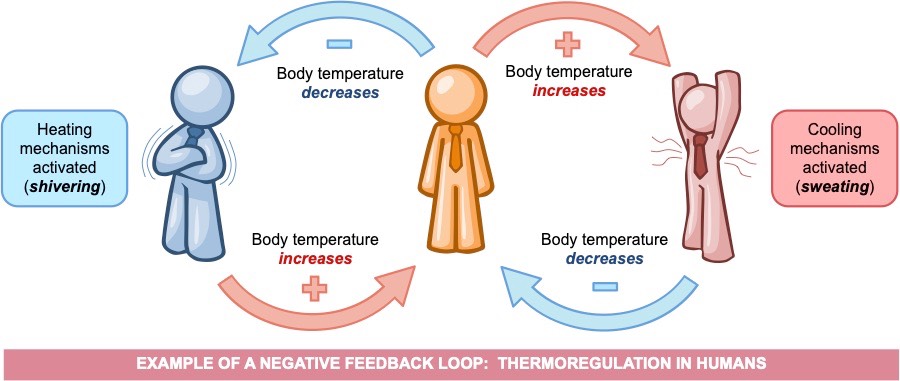Key Knowledge:
|
Homeostasis is the tendency for an organism or cell to maintain a constant internal environment within physiological tolerance limits
- Equilibrium requires continual adjustments to conditions such as body temperature, blood glucose levels and water balance
Stimulus-Response Model
Homeostatic regulation requires systems to detect and respond to internal and external changes via a stimulus-response pathway
- A stimulus is a change in the environment (either external or internal) that is detected by a receptor
- Receptors transform the environmental stimuli into a cellular signal (via a signal transduction pathway)
- Signals can be communicated between cells via either the nervous system (electrical impulses) or endocrine system (as hormones)
- Ultimately, the signal triggers an effector, which is the cellular target that will carry out the appropriate response

Receptors
Different types of receptors can be used by the body to detect a range of different stimuli, including:
- Mechanoreceptors: Detect mechanical stress (skin tactility), pressure changes (baroreceptors in blood) or sound waves (ears)
- Chemoreceptors: Detect specific chemicals (taste via tongue or smell via nose), solute levels (osmoreceptors) or pain sensations
- Thermoreceptors: Detect heat (externally via skin or internally via hypothalamus) or certain food chemicals (e.g. capsaicin)
- Photoreceptors: Detect visible wavelengths of light (e.g. rod and cone cells within the retina of the eye)
Signalling molecules
A variety of signalling molecules (ligands) are involved in communicating messages between target tissues or organs, including:
- Hormones: Travel via the bloodstream to distant target organs to mediate long-lasting cellular actions (i.e. endocrine system)
- Neurotransmitters: Released from nerve cells to mediate fast-acting electrical communication (i.e. nervous system)
- Cytokines: Produced by immune cells to regulate immune activity (e.g. stimulate adaptive immunity or trigger inflammation)
- Pheromones: Chemicals that are released externally to act on other organisms of the same species (e.g. alarm pheromones)
Plants also produce signalling molecules (phytohormones) to regulate growth responses (tropisms) and trigger developmental stages
Feedback Mechanisms
Physiological processes are commonly moderated via two distinct feedback mechanisms – positive and negative feedback
- Most homeostatic processes are controlled by negative feedback and hence these systems occur more commonly within the body
Negative Feedback
Negative feedback involves a response that is the reverse of the change detected (it functions to reduce the change)
- A change is detected by a receptor and an effector is activated to induce an opposite effect – this promotes equilibrium
Examples of processes that utilise negative feedback loops include homeostatic systems, such as:
- Thermoregulation (if body temperature changes, mechanisms are induced to restore normal levels)
- Blood sugar regulation (insulin lowers blood glucose when levels are high ; glucagon raises blood glucose when levels are low)
- Osmoregulation (ADH is secreted to retain water when dehydrated and its release is inhibited when the body is hydrated)

Positive Feedback
Positive feedback involves a response that reinforces the change detected (it functions to amplify the change)
- A change is detected by a receptor and an effector is activated to induce the same effect – this promotes further change
- Positive feedback loops will continue to amplify the initial change until the stimulus is removed
Examples of processes that utilise positive feedback loops include:
- Childbirth – stretching of uterine walls cause contractions that further stretch the walls (this continues until birthing occurs)
- Lactation – the child feeding stimulates milk production which causes further feeding (continues until baby stops feeding)
- Ovulation – the dominant follicle releases oestrogen which stimulates LH and FSH release to promote further follicular growth
- Blood clotting – platelets release clotting factors which cause more platelets to aggregate at the site of injury
